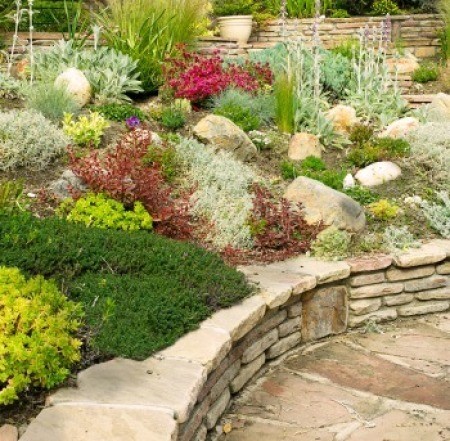Native to the mountainous regions of the world, alpine plants have developed several adaptations that make them appealing for use as garden plants. For example, the ability to survive short, cool growing seasons means that many species will flower continuously while they have the chance. To protect themselves from high winds they have developed a "slow and low" growth habit-great for gardens where space is at a premium. High altitude soils tend to be low in nutrients. As a result, many species of alpine plants have long roots, which also make them resistant to drought.
True alpine plants, as classified by botanists, include various species of flowering plants (usually perennials) that are native to high-altitudes-specifically, the mountainous areas that lie above the tree line, but below the permanent frost line. The plants are characterized by their dwarf growing habit and profuse blooms, and although some species are fussy about their growing conditions, the vast majority will thrive without any special care as long as they are given well-drained soil and adequate sunlight. For gardeners, alpine plants provide attractive flowers and foliage without taking up a lot of space. Many of the more common species are available at nurseries and garden centers during the growing season. If you shop at nurseries specializing in alpine plants, however, you will gain access to a much wider variety of plants.
In their native environment, alpine plants grow from the cracks in rocks, or use their long roots to anchor themselves in the loose scree that has broken off and rolled down the mountainside. In the garden, you can recreate this by growing them in a rock garden. They also look nice between the stones along pathways, in containers or cement troughs, or when tucked into the cracks and crevices of stone walls.
Rock/scree gardens: Once you have selected your planting site, dig a hole approximately the same diameter as the plant's nursery pot. Remove the plants from its pot and gently tease the roots free before lowering it into the hole. Backfill the hole with soil, firming it lightly as you go. Finally, give the plant a thorough watering, and add a layer of coarse gravel or mulch over the surface to help reduce competing weeds.
Stone walls: Alpines can also be grown in cracks and crevices in walls, spots that are particularly appreciated by species that do not tolerate being wet. A few days before planting, cut a piece of sod large enough to cover the root ball of the plant. Leave the sod overturned on the yard for a few days until the grass is completely dead. Once the grass is dead, soak the sod in water, wrap it around the root ball of your plant, and push the sod-wrapped plant into the hole. The sod will help keep the nutrient-filled soil ball intact and provide the roots with an anchor.
Between pavers: Leave (or create) gaps between some of the stones or pavers along pathways. Fill the gaps fill with a suitable, fast-draining soil and plant your alpines.
Feeding: Alpine plants are well-adapted to growing in poor soils. Unless your nursery supplier tells you otherwise, fertilizing only needs to be done when it appears the plants have completely stopped growing-maybe once every 5 to 6 years.
Watering: Most species of alpine plants have long roots, an adaptation to mountain environments where access to moisture is often seasonal. Give them supplemental water only in very dry weather and ensure they have good drainage.
Weeding: Alpine plants are typically slow to get going, so weeding can be a time consuming chore until plants become well established. Keep weeds to a minimum by covering the bare soil around plants with a layer of coarse gravel.

About The Author: Ellen Brown is an environmental writer and photographer and the owner of Sustainable Media, an environmental media company that specializes in helping businesses and organizations promote eco-friendly products and services.
Add your voice! Click below to comment. ThriftyFun is powered by your wisdom!